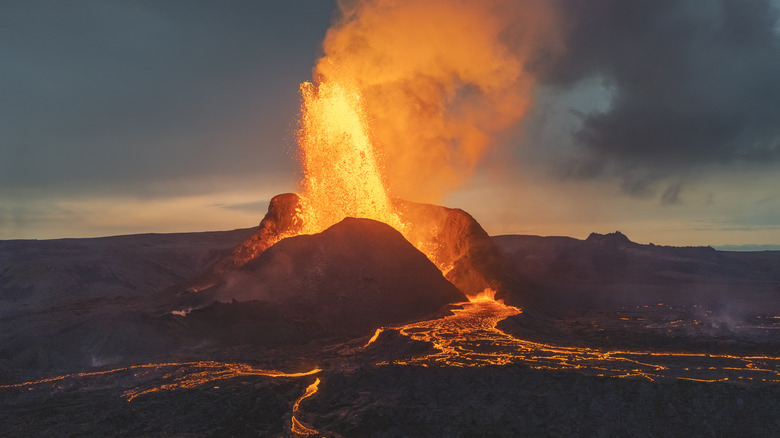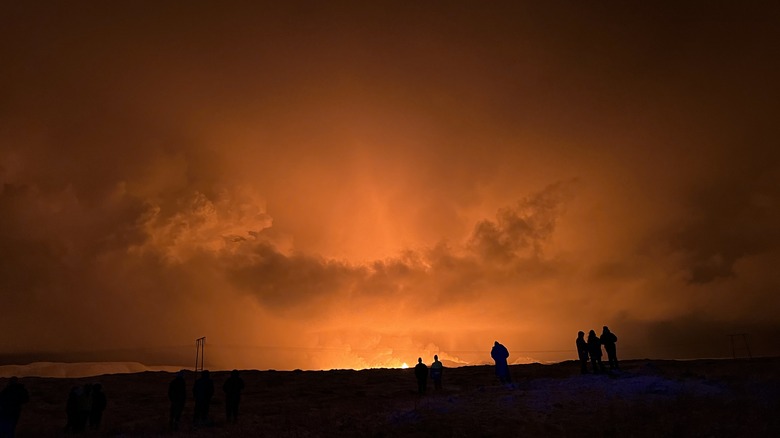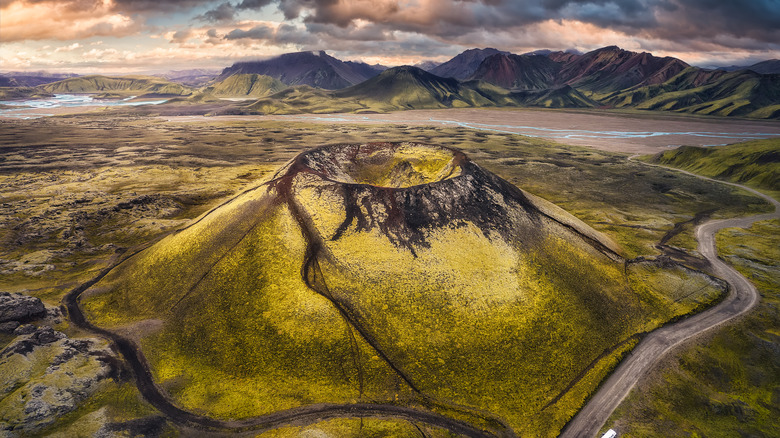Here's How Many Active Volcanoes Are In Iceland (And It's Probably More Than You Think)
Hey, guess what: Did you know the surface of the planet upon which our entire civilization is built is a slippy, slidey jigsaw puzzle of tectonic slabs coasting on a roiling, liquid mantle that spews bursts of pressurized, flaming rock so hot that it's become liquid? Fun times. No, volcanic explosions don't only live in the past. No, southern Italy's Pompeii was not the only ancient city to get consumed by ash and lava (we're looking at you, Akrotiri). No, we can't really predict when volcanoes are going to go boom, like when La Palma ruined thousands of lives on the Canary Islands in 2021. And no, you won't be able to outrun lava flow, at least not over long distances. Our best advice? Stay away.
But sometimes you can't stay away. This is especially true if you live in Iceland, that ruggedly gorgeous land of Vikings who in 1,000 C.E. huddled up and said, "Listen, can we just get these Christians off our back by playing along with their whole religion thing?" Even in Iceland's capital, Reykjavik, you can't escape the view of pyroclastic flow. As The Guardian reports, late-2023 volcanic explosions on Iceland's Reykjanes peninsula were visible from multiple cities, including Reykjavik. But while Icelandic authorities said that the eruptions present "no threat to life," we wouldn't prove that statement wrong by getting too close. Then again, that's difficult in Iceland — Visit Iceland says that the country has a full 32 active volcanoes.
An ongoing volcanic hotspot
The 2023 volcanic explosions in Iceland renewed interest in the nation's hottest (literally) topic. As CNN describes, residents of the nearby town — the tiny fishing town of Grindavik, population 4,000 — got word back in November that they'd have to evacuate because authorities discovered magma flowing underground. And yet, The Guardian says that residents made "an incredibly narrow escape" ahead of the December 2023 eruption. Grindavik is also home to a geothermal power plant, the destruction of which could be disastrous, as the facility provides energy to 30,000 homes on Iceland's Reykjanes peninsula. On that note, all of Iceland's turbulent, underground heat and gas provides the nation with its extensive geothermal energy grid, which Energy Transition says accounts for nearly 70% of the country's energy production.
If this all sounds incredibly risky, then you're not the only one to think so. Visit Iceland says that the country's 32 active volcanos are incessantly surveilled — particularly the nation's largest volcano, Katla. Leading up to 2021, the outlet says that the country experienced about one eruption every five years. Within the past couple of years, however, volcanic activity has surged. The Fagradalsfjall volcano, in particular, erupted for six months during 2021, per Visit Iceland. That volcano is located practically within walking distance of the current volcanic explosion and only about 20 miles from Iceland's capital, Reykjavik. The website says that the Fagradalsfjall eruption was accompanied by an unbelievable 40,000 earthquakes. Before this, the region had been silent for about 800 years.
Magma and tours in equal proportions
At this point, Icelanders are as used to volcanoes as folks in folks Miami are (dirty) beaches. The Icelandic Met Office has a handy map of the country's volcanoes, almost exclusively located in the country's southern half and tending to congregate towards the southwest — right near Reykjavik and the recent volcanic patch along the Reykjanes Peninsula. The Icelandic Met Office color codes volcanoes by danger level, ranging from red (currently exploding) to grey (seemingly dormant, i.e., "absence of unrest unconfirmed"). At the time of this article's writing, all of the volcanoes across the entire country are at least green, which means a volcano has "reverted to its normal, non-eruptive state." But a volcano in this state is still active and can blow whenever it wants.
And yet, not only do Icelanders apparently exist without constantly worrying about death by fire, the country hosts loads of volcano tours. Arctic Adventures shows a happy couple posing for a photo as a volcano burbs up magma behind them, Guide to Iceland features helicopter tours over lava-saturated volcano tops, and Reykjavik Excursions offers underground jaunts through thermal caves. Shh — let's not tell them what happens when lava touches human skin.
In fact, the region struck by the current volcanic explosion — within the Reykjanes Peninsula — is part of a national, UNESCO-recognized park. The Reykjanes Geopark contains 55 "geosites" available for admiration and exploration. Or you know, you could just stay way, way the heck away from the whole place.


